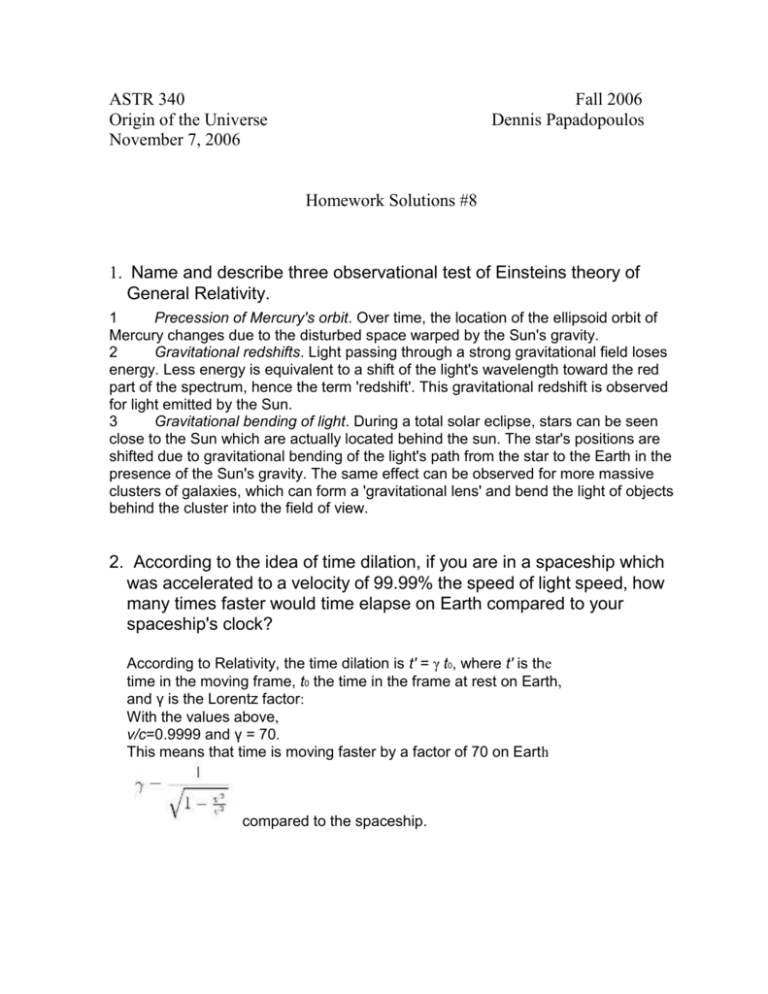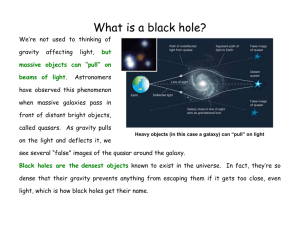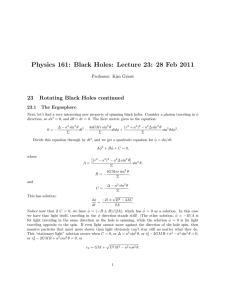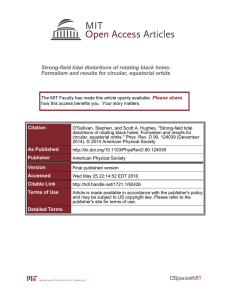Solution_8
advertisement

ASTR 340 Origin of the Universe November 7, 2006 Fall 2006 Dennis Papadopoulos Homework Solutions #8 1. Name and describe three observational test of Einsteins theory of General Relativity. 1 Precession of Mercury's orbit. Over time, the location of the ellipsoid orbit of Mercury changes due to the disturbed space warped by the Sun's gravity. 2 Gravitational redshifts. Light passing through a strong gravitational field loses energy. Less energy is equivalent to a shift of the light's wavelength toward the red part of the spectrum, hence the term 'redshift'. This gravitational redshift is observed for light emitted by the Sun. 3 Gravitational bending of light. During a total solar eclipse, stars can be seen close to the Sun which are actually located behind the sun. The star's positions are shifted due to gravitational bending of the light's path from the star to the Earth in the presence of the Sun's gravity. The same effect can be observed for more massive clusters of galaxies, which can form a 'gravitational lens' and bend the light of objects behind the cluster into the field of view. 2. According to the idea of time dilation, if you are in a spaceship which was accelerated to a velocity of 99.99% the speed of light speed, how many times faster would time elapse on Earth compared to your spaceship's clock? According to Relativity, the time dilation is t' = γ t0, where t' is the time in the moving frame, t0 the time in the frame at rest on Earth, and γ is the Lorentz factor: With the values above, v/c=0.9999 and γ = 70. This means that time is moving faster by a factor of 70 on Earth compared to the spaceship. 3. If the Sun would gravitationally collapse and form a black hole, how big would the event horizon be? What would happen to the Earth's orbit? (Msun = 2 × 1030 kg, G = 6.7 × 10-11 m3 kg-1 s-2, c = 3 × 108 m s-1) The Schwarzschild radius is rS = 2GM / c2 . With the above values we obtain rS = 3 x 10-3 m = 3 km. The Earth's orbit would be unchanged. We would feel the same gravity as before because gravitation does not depend on the size of the body. 4. What are 'event horizon', 'photon sphere' and 'ergosphere'? The 'event horizon' is at the Schwarzschild radius of a black hole and defines the region where the escape velocity equals the speed of light. It is also the region of 'no return' in that once it is crossed going into a black hole, nothing can return to the outside universe. The 'photon sphere' is a stable orbit around a black hole where gravity is so strong that light can travel in circles around the black hole indefinitely. A photon could leave the back of your head, go once around the black hole, and be seen by your eye. You can see the back of your head. An 'ergosphere' is an egg-shaped region of distorted space around the event horizon. The distortion is caused by the spinning of the black hole, which 'drags' the space around it. 5. You traveled to a distant black hole and 'park' your spaceship in a circular orbit at a distance that equals the photon sphere. a) If you look into the direction of the black hole, what would you see? b) If you look away from the black hole, what would you see? c) If you look perpendicular to the black hole into the direction of your orbit, what would you see? a) Since gravity of the BH is so strong, no light can escape the BH. You look into the vast black emptiness of the black hole. b) You could see the night sky as in any other place. The gravity of the black hole does not affect light approaching it. c) The photon sphere is an orbit around the BH where the gravity is so strong that light is bent into circular orbits. If you look along the photon sphere, you will see the back of you own head!








